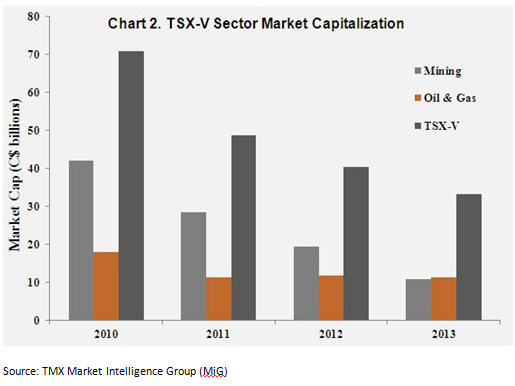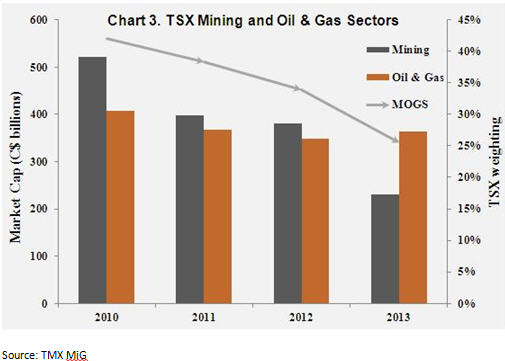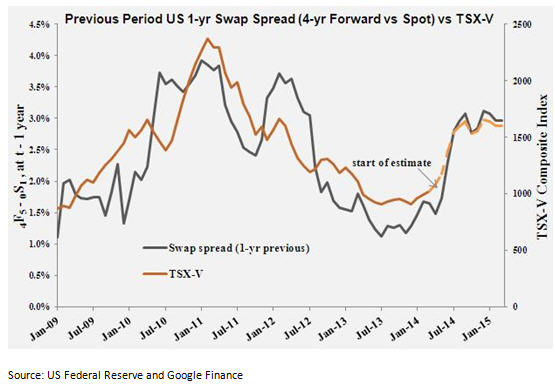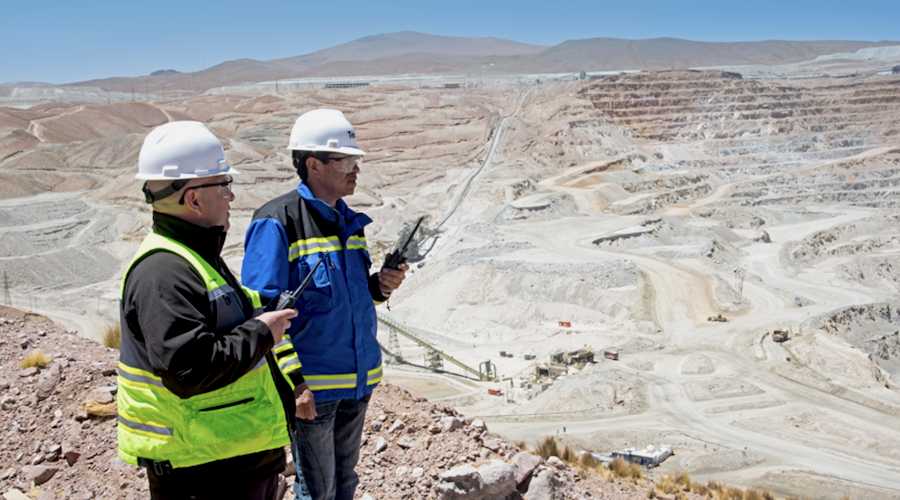The value of project generators in a low probability industry
Summary:
- After years of underperformance, mining and oil & gas appears to have come back into vogue.
- Due to the difficult odds involved with successful mineral exploration, prospect generators can add value by exposing investors to multiple projects over several years.
- Project generators operate in different markets and stages of project development. Risk profiles vary considerably; leading to diversification within the universe. Due diligence is warranted.
Canadian Equity Capital Market Update
In July, Zimtu Capital Corp (TSX-V: ZC) commented on the languishing multi-year performance of capital markets for Canadian natural resources. The TSX Venture (TSX-V) was especially susceptible, as mining and oil & gas sectors (MOGS) represented 85% of the exchange by market capitalization a little over three years ago.
The TSX-V composite index closed out 2010 at 2287 points, representing 2077 listed issuers with a combined market capitalization of almost C$70 billion. However, the TSX-V composite index would finish 2013 at 932 points, and a combined market capitalization of approximately C$33 billion.
The situation was similar on the big board – the TSX – with MOGS under seemingly relentless pressure. Unfortunately, for mining focused investors by December 31st 2013, mining represented just 10% of the TSX and 33% of the TSX-V as a consequence of shedding C$291 billion and C$31 billion in respective market capitalizations over three years.
Whereas, large financial institutions have been TSX darlings; increasing the sector’s equity capitalization by C$178 billion over the same period. Real estate, pipeline & utility, and communications & media sectors also fared well.
All four sectors have been beneficiaries of historically low interest rates, high barriers to entry, and investor’s use of perceived safe dividends to substitute lower bond yields. This divergence in performance cannot persist indefinitely. Sufficient supplies of base, industrial, and energy commodities are critical for the development and sustainability of modern societies.
TSX Venture Market Forecast
In our July market commentary we expressed reasons for optimism and suggested the TSX-V could surprise to the upside perhaps as early as the fourth quarter of 2013 (4Q13). At the initiation of ZC inaugural market commentary, the TSX-V composite index was at 881 points.
Since our call the TSX-V has shown resilience trending upward in the face of geopolitical concerns out of Eastern Europe and falling spot prices for many commodities such as copper, potash, and uranium. Even during a difficult market environment, the mining sector was able to raise C$6.9 billion in equity capital for 2013 between the TSX and TSX-V, leading all other sectors.
So far, 2014 has been fairly bullish; as the amount of equity capital raised for the mining sector after the first three months has already reached C$4 billion. In addition, eight of ten Canadian provinces ranked in the top quartile of all jurisdictions for mining attractiveness according to the Fraser Institute’s annual global survey.[1]
Going forward, Canadian natural resources should again benefit from global macro trends. The IMF expects global real growth to average 3.3% through 2014 to 2019, well above the average 2.8% experienced since 1980.[1] Meanwhile, China’s urbanization rate is expected to increase from 52% in 2012 to 60% by 2020; equating to the migration of approximately 110 million people to urban centers within the world’s most populous country.
Interestingly, the price of many commodities floundered throughout 1980 to 2000.
So the rapid appreciation of commodity prices through 2003 to 2008 could be thought of as the inevitable realization of a new global demand frontier. Therefore, there are good reasons to expect most commodity prices to stabilize.
Based on time series trends since 1982, the current value for the TSX of over 14,400 points appears expensive by as much as 10%. However, as previously stated most of the discrepancy in the relative performance between the TSX and TSX-V is due to their respective sector weightings[1].
Counter intuitively, recent studies out of both Europe and the US have shown robust correlation between the performance of mining and energy stocks, and interest rates.[2], [3] Therefore, we looked at movements between US swap spreads and the performance of the TSX-V composite index.
We believe US interest rate expectations to be the most relevant in the current globalized trading environment with deregulation of cross border capital flows and coordinated central banks efforts.
Since 2008, movements in US monthly swap spreads have been a reliable precursor to approximately one year forward movements in the TSX-V. With renewed – albeit tentative – optimism for the MOGS, we expect the TSX-V composite index to continue its upward momentum through the remainder of 2014 and into 1Q15.
In relatively free markets, stable prolonged price movement should act as signals to incentivize suppliers to change production output. However, large capitalized mining and oil & gas producers have market structures that impede the elasticity of supply to changes in the underlying commodity price over the short and even medium term, including:
- Time required to explore for and define a deposit
- Material up-front fixed capital expenditures (Capex) required
- Use of long-term contracts specifying both price and obligations
- Time required to develop assets and receive various approvals
Evidence of this can be seen by BHP’s unrelenting supply of metallurgical coal into the world market.[1] Large scale mines will continue to produce for some time in the face of almost zero, or even negative, operating margins as long as sunk and fixed costs – which represent a significant portion of total costs – can be recovered and asset write-downs avoided.
Therefore, the most responsive industry within the mining sector to fluctuations in the underlying commodity price is exploration. The performance of junior (small capitalization) exploration companies is leveraged to the price of the commodity due to reliance on equity capital to fund project development in the absence of cash inflows from operations.
It follows, that the ability to raise funds by issuing new equity in turn relies on investor sentiment. An upward trend in the real price of a commodity will attract exploration and development dollars, all else equal.
Improving economic stability from both the US and EU, and continued growth out of non-OECD Asia will stabilize commodity prices and increase the attractiveness of investment into the highly cyclical exploration industry where future demand growth is the focal point.
Junior Exploration – risk and reward
The inherent uncertainty in exploration increases the risk profile significantly. Therefore, exploration tends to be an entrepreneurial endeavor and should be considered high risk. Exploration risk includes:
- the likelihood of not discovering the sought after deposit
- the inability to continuously finance planned exploration
- a discovery may be uneconomic or insufficient in size
Of course, there is tremendous upside in successful exploration and delineation of a deposit, as illustrated by the recent Paterson Lake South uranium project that was discovered by joint venture partners Alpha Minerals and Fission Energy. In general, the potential reward is commensurate with risk. However, for many retail investors the high risk associated with exploration may be too large a hurdle to overcome.
This is where the project generator business model can add value.
Project Generators
One of the best explanations of the project generator (PG) business model is provided by Riverside Resources Inc (TSX-V: RRI)[1]
“A junior resource company employing a Prospect Generator (PG) business model…..are typically leveraging an intellectual advantage that allows them to bring in better-funded partners to take on the high cost and inherent risk of exploration. Shareholders are exposed to more discovery chances when the PG Company tests numerous prospective targets with partner funding.
Using partner money to fund exploration and growth allows the PG Company to conserve capital, reduce shareholder dilution and extend the life of the company.”
Rather than the typical stand-alone junior exploration company that acquires property and financing for the exploration of a singular discovery, the PG is able to expose shareholders to many different companies, commodities, and potential royalties.[2]
As previously mentioned, exploration is inherently risky and history has proven that a majority of listed junior exploration companies will eventually not succeed. For this reason, PGs play an important role for would-be junior exploration investors. Rick Rule of Sprott Asset Management has helped finance fifty-five PGs resulting in twenty-two economic discoveries, fifteen of which have been acquired.
Rick explained to Palisade Radio that these results are “very good when compared to the exploration industry as a whole” and believes the model will outperform any other in the exploration sector.[3]
One Size Does Not Fit All
There are several Canadian publically listed mining project generators; and though the basic business model is similar there are differences in strategy. In general, the type and location of projects being generated will depend on the size and corporate culture of the PG. This means PG’s gravitate towards markets where they hold a competitive advantage.
These competitive advantages exist due to funding constraints, ability to create meaningful shareholder value as market capitalization increases, and the network of expertise available to the PG. For example, Altius Minerals Corp (TSX: ALS), one of Canada’s largest and most successful PGs, business has predominately been focused within Newfoundland and Labrador, expanding into Quebec and Chile over time.
Further, the type and stage of project exploration development a PG enters at will also depend on its capitalization. Niche markets, such as high purity quartz, with an estimated global market of 100,000 tonnes per annum, are likely too small for a large PG to enter and provide shareholders with sufficient value – the opportunity cost is too great.
PGs with large market capitalizations are that size for a reason, as the Capex on large scale exploration projects that are further along in development can become a significant barrier for junior market participants.
Large PGs add value by focusing on projects with significant size where the cost structure is skewed toward more capital intensive development instead of pure exploration, such as north Chilean copper-porphyries projects.
In comparison, more modest sized PGs such as Zimtu Capital Corp (TSX-V: ZC) – my employer – out of necessity have to be disciplined in allocating capital. Junior PGs may lean toward niche markets, high grade modest tonnage situations, and early stage projects where the immediate exploration costs are not too onerous as to be an impediment. Owing to their size, junior PGs tend to be dynamic and cultivate partnerships with specialists in various fields to potentially add shareholder value by alleviating market inefficiencies.
Concluding Remarks
Just as not all projects are suitable for every PG, not all PGs are suitable for every investor. Investors need to properly understand their ability to accept, and appetite for, risk. To this end PGs, or a portfolio of PGs, can be a valuable tool to access the potential upside of successful exploration while mitigating some of the risk.
[1] Alana Wilson & Miguel Cervantes, “Survey of Mining Companies 2013”, Fraser Institute Annual
[2] IMF, World Economic Outlook, 8 Apr 2014
[3] TMX Market Intelligence Group, www.tmx.com/en/mig/index.html
[4] William O’Neil & Co., Table: Energy and Materials Show Most Outperformance During Rate Increase Period
[5] Jackson’s Corner, “Buy cyclicals when bond yields are rising”, Societe Generale
[6] Mining Sector Update, Whitman Howard Global Equity Research, 17 Apr 2014
[7] David Aston, “A better way to prospect for mining profits”, Globe and Mail, 5 Apr 2013
[8] Riverside Resources Inc., Corporate Presentation, Apr 2014
[9] Rick Rule: Prospect Generators Explained, Palisade Radio, 25 Mar 2014
{{ commodity.name }}
{{ post.title }}
{{ post.date }}









Comments
mark
One play I like a lot is First Liberty Power Corp.FLPC.The only Antimony,#1 most endangered metal in British supply survey,minor in US.First ore was shipped to buyer in China!You can buy in UNDER A PENNY!What a future.IMO